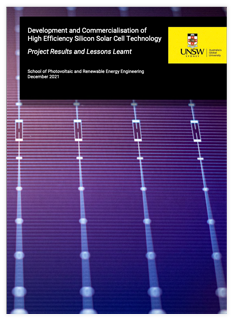This report shares lessons learnt and results from UNSW’s Development and Commercialisation of High Efficiency Silicon Solar Cell project.
Report extract

The project brought together a team of academic and industry partners to address critical roadblocks to the improvement of industrial solar cells. The work studied all forms of crystalline silicon material that in 2020 represented 95% of all cells produced globally. The first phase (2013-2017) developed and transferred to industry new manufacturing techniques to improve the output power and stability of silicon cells. The second phase (2017-2021) continued the commercialisation of these techniques, adapting them to a wider range of solar cell materials and applying them to solve a new form of light-induced degradation. A particular focus in the second half was on understanding and controlling the use of hydrogen. The work combined fundamental university research with applications in an industrial setting to create a range of critical breakthroughs. Outputs included sixty scientific papers, four patents, improved manufacturing processes for high-efficiency cells, novel reliability testing techniques, contributions to industry standards, and the creation of commercially available tools to improve the performance and stability of mass-produced solar cells.



